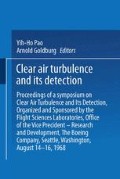Abstract
The significance of the Richardson number for existing turbulence is examined and is shown to be more appropriately a comparative measure of the importance of terms in the energy budget rather than a criterion for the growth or decay of turbulence. Data from the literature is examined to show that there must be a continued input of energy from large scale processes to account for the persistence of some observed CAT patches. The types of large scale motion necessary to accomplish this are: downward vertical motion, extension along an axis normal to the shear vector (i.e. vertical shear of the horizontal wind), and compression along an axis parallel to the shear vector.
Access this chapter
Tax calculation will be finalised at checkout
Purchases are for personal use only
Preview
Unable to display preview. Download preview PDF.
References
Businger, J. A. (1968). On the energy supply of clear air turbulence. Symposium on Clear Air Turbulence, Boeing Scientific Research Laboratories, August 1968.
Endlich, Roy M. (1964). The mesoscale structure of some regions of clear-air turbulence. J. Appl. Met. 3, 3, 261–276.
Haltiner, George J. and Martin, Frank L. (1957). Dynamical and physical meteorology. ( McGraw-Hill Book Company Inc., New York )
Hick, J. J. and Angell, J. (1968). Radar observations of breaking gravitational waves in the visually clear atmosphere. J. Appl. Met. 7, 1, 114–121.
Hinze, J. O. (1959). Turbulence 7 an introduction to its mechanism ànd theory. ( McGraw-Hill Book Company Inc., New York )
Keitz, Edwin L. (1959). Differential advection as a factor in clear-air turbulence. J. Met. 16, 1, 57–62.
Kronebach, George W. (1964). An automated procedure for forecasting clear-air turbulence. J. Appl. Met. 3, 2, 119–125.
Lumley, John L. and Panofsky, Hans A. (1964). The structure of atmospheric turbulence. ( Interscience Publishers, John Wiley and Sons )
Lyons, Richard, Panofsky, H. A., and Wollaston, Sarah (1964). The critical Richardson number and its implications for forecast problems. J. Appl. Met. 3, 2, 136–142.
Panofsky, Hans A., Dutton, John A., Hemmerich, Kurt H., McCreary, G., and Loving, N.V. (1968). Case studies of the distribution of CAT in the troposphere and stratosphere. J. Appl. Met. 7, 3, 384–389.
Pedlosky, Joseph (1965). On the stability of baro-clinic flows as a functional of the velocity profile. J. Atmos. Sci. 22, 2, 137–145.
Pohle, John F., Blackadar, Alfred K., and Panofsky, Hans A. (1965). Characteristics of quasi-horizontal mesoscale eddies. J. Atmos. Sci. 22, 2, 219–221.
Reed, R. J. (1968). A study of the relation of clear air turbulence to the meso-scale structure of the jet stream region. Symposium on Clear Air Turbulence, Boeing Scientific Research Laboratories, August 1968.
Reiter, E. R. and Burns, Anne (1966). The structure of clear-air turbulence derived from “TOPCAT” aircraft measurements. J. Atmos. Sci. 23, 2, 206–212.
Reiter, Elmar R. and Nania, Abele (1964). Jet-stream structure and clear-air turbulence (CAT). J. Appl. Met. 3, 3, 247–260.
Author information
Authors and Affiliations
Editor information
Editors and Affiliations
Rights and permissions
Copyright information
© 1969 Springer Science+Business Media New York
About this paper
Cite this paper
Badgley, F.I. (1969). Large Scale Processes Contributing Energy to Clear Air Turbulence. In: Pao, YH., Goldburg, A. (eds) Clear Air Turbulence and Its Detection. Springer, Boston, MA. https://doi.org/10.1007/978-1-4899-5615-6_8
Download citation
DOI: https://doi.org/10.1007/978-1-4899-5615-6_8
Publisher Name: Springer, Boston, MA
Print ISBN: 978-1-4899-5617-0
Online ISBN: 978-1-4899-5615-6
eBook Packages: Springer Book Archive

